The RS Games was to be the biggest dinghy regatta in the world and what a spectacle.
I have got to say that the Rooster Team were super proud to be part of this amazing celebration of racing and the team certainly stepped up to the mark to make it go with a bang.
 We as Rooster® were to be the technical clothing supplier to the event which we took as a massive honour. Behind the scenes, we had been preparing hoodies, T-Shirts, Soft Shell Jackets and Soft Shell Gilets to be available for printing with the excellent RS Games Logo.
We as Rooster® were to be the technical clothing supplier to the event which we took as a massive honour. Behind the scenes, we had been preparing hoodies, T-Shirts, Soft Shell Jackets and Soft Shell Gilets to be available for printing with the excellent RS Games Logo.  We Opened a Rooster shop at the Games to support the sailors, so there was little or no excuse but to try and enter as many of the events as we could during the three-week celebration of sailboat racing.
We Opened a Rooster shop at the Games to support the sailors, so there was little or no excuse but to try and enter as many of the events as we could during the three-week celebration of sailboat racing.  We had entered the Aero 7 World Championships, The RS800 National Championships and lastly, the RS500 World Championships. This was our bonus event. It was going to be a long summer - and no one could say we had let the grass grow between our feet.
We had entered the Aero 7 World Championships, The RS800 National Championships and lastly, the RS500 World Championships. This was our bonus event. It was going to be a long summer - and no one could say we had let the grass grow between our feet.
This is the story of our 80 hours of sailing over the regatta with some tuning tips and advice along the way.
The Aero World Championships entry of 207 boats from 13 nations, far surpassed that expected by the race management team so we faced a compromise of 4 fleets on one course area. With 61 Aero 5's, 103 Aero 7's which were to be split into two fleets for reseeding each day and 43 Aero 9's.
Experience told me that when there are more than two fleets racing on one course, we tend to have lots of waiting time. Add to that three races a day and with racing outside the harbour, it was shaping up to be a challenging regatta, both physically and mentally.
The unusually hot summer still had its grip on the South of England so our wide-brimmed sun hats and long sleeved rash tops had been selling fast in the shop to the run up of the regatta. The volunteers set up for registration and measurement, the sailors got their RS Games T-shirts and we were in a real World Championship.  The first few days were going to be light and sunny with building sea breezes each day. Sam Whaley did a tuning and coaching session for the fleet. We have very different approaches to our sail set up. As I give 7 Kg and about 6" of height to Sam, I need a set up that is far less powerful than his. But I think there are some other advantages in my set up. My second batten is set slack so that when I use lots of vang, the upper leach is open and not closed. My second batten can move by up to 5mm off the tensioner whilst in the pocket before I pull the sail up. When I want the leach to close, I would use mainsheet tension with a slack vang. I think the slack batten also helps downwind as I can keep more vang on and then reverse the flow on the upper leach as the top of the sail is less hooked. You can see from this image that I could use lots of vang to give me a fine entry to the rig in relatively light winds.
The first few days were going to be light and sunny with building sea breezes each day. Sam Whaley did a tuning and coaching session for the fleet. We have very different approaches to our sail set up. As I give 7 Kg and about 6" of height to Sam, I need a set up that is far less powerful than his. But I think there are some other advantages in my set up. My second batten is set slack so that when I use lots of vang, the upper leach is open and not closed. My second batten can move by up to 5mm off the tensioner whilst in the pocket before I pull the sail up. When I want the leach to close, I would use mainsheet tension with a slack vang. I think the slack batten also helps downwind as I can keep more vang on and then reverse the flow on the upper leach as the top of the sail is less hooked. You can see from this image that I could use lots of vang to give me a fine entry to the rig in relatively light winds.  Top tips for the Aero: 1. Make sure you have the maximum range in your vang control line. With my set up I have some mast bend with the vang completely released when I pull the sail up. I almost run out of this range when I use lots of vang in super strong winds. 2. Think of using Rooster Easysplice to make a short halyard. The loop in the easy splice is easier to pull through the turning block when hoisting than the existing system.
Top tips for the Aero: 1. Make sure you have the maximum range in your vang control line. With my set up I have some mast bend with the vang completely released when I pull the sail up. I almost run out of this range when I use lots of vang in super strong winds. 2. Think of using Rooster Easysplice to make a short halyard. The loop in the easy splice is easier to pull through the turning block when hoisting than the existing system.  3. Keep the stretchy black halyard as this allows the mast to bend and straighten - and fasten it off on the port side to some shock cord with a hook (see photo)
3. Keep the stretchy black halyard as this allows the mast to bend and straighten - and fasten it off on the port side to some shock cord with a hook (see photo) 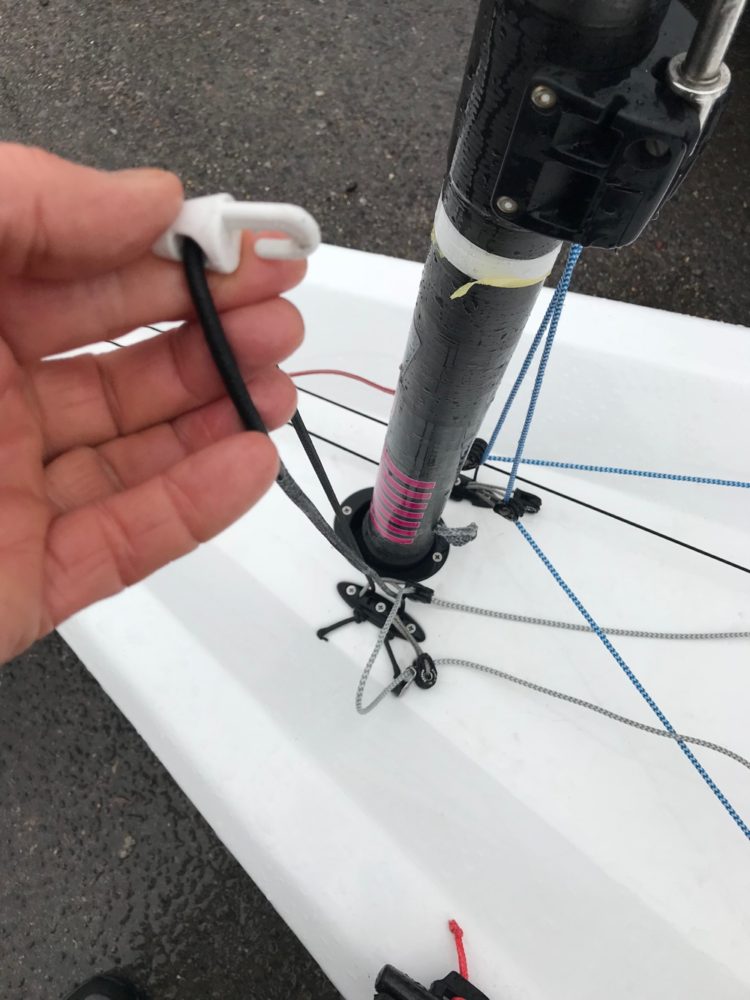 4. Fasten a piece of shock cord to the halyard retaining button on the topmast and take it down to the Cunningham double block to help it release.
4. Fasten a piece of shock cord to the halyard retaining button on the topmast and take it down to the Cunningham double block to help it release.  By day three, the temperature was starting to drop slightly. I changed my rash vests for Polypro. I also packed a Pro Lite Aquafleece in a 10L roll-top dry bag just in case the wind built. The wind did continue to build throughout each day and through the week. The first casualty in the fleet was one of my buddy partners; Robert England, from Chelmarsh sailing club. Although he was obviously a very accomplished sailor, he was also one of our more senior sailors. I had enjoyed spending time with him on and off the water. "if I sail three races a day at my age, I have to take a week off to recover" was his comment. It was then that I remembered that the Solo Association has a special trophy for their senior sailors at their Nationals. They race for the Plate Trophy which is for those who only sail the first race of the day... Food for thought? It became clear that there was a lot of compromise in the course configuration. It had been designed by the Race Officer to enable the 4 fleets to race around the course and finish is about the same time, despite their very different speeds. My only comments were that the course could not have been less smile friendly. It was also dangerous. It would have been much safer if we all had the same first mark and mark 2. The 5's could have raced to a much shorter windward leg on their outer loop to help them keep up. I kept finding myself in tight situations trying to round a windward mark with a 9 rig trying desperately trying to avoid me. The 7 fleets never had a decent reach as we rounded a near windward mark on the inner loop - then fetched to the outer loop windward mark whereas the 9's rounded a different windward mark and then took a much broader angle to the outer loop. Most of us wanted broader more smiley reaches. We finally got our wish when we had a 70-degree shift in the wind to the right in the middle of our second upwind. We then had a super smiling broad reach to the outer loop mark, a full-on and exciting reach to the leeward mark and then a short tactical beat to the finish. More of the same please RO, but for some reason, all of the fleets requests to change the configuration fell on deaf ears. It was a tough regatta... In the qualification series, Sam Whaley was shaping up to be supremely dominant. Jack Hopkins was also having a very consistent series; I could tell he was fresh and making the right decisions and put it down later to the fact that he had already sailed the Laser and Solo Nationals. My first beats were just not as consistent as his. With one point between us, Jack was my target. So with the inner Chimp revved up, I OCSed the first start of the final series. I had not managed to tell my inner chimp that the race was highly likely to be restarted as the Northerly was about to shift 90 degrees left. My Chimp was worrying about the “what if the right comes good” as it so often does in the northern part of the bay. There was a small patch of wind in the middle and I tried to make a jump on the fleet to get to it first to give me a safe way to the windward mark. If you are confused about my terminology of the Inner Chimp - then I think you would find the book: "The Chimp Paradox" very interesting. Hindsight is a wonderful thing. As I read my number on the blackboard, I felt pretty stupid. I sailed away with my tail between my legs and prepared myself for a long wait. It was going to be as much a mental battle to stay focused as a physical one. Good job I had my Supertherm Beanie tucked into my buoyancy aid and my Aquafleece in my dry bag, clipped into the back of the boat as it was getting cold. Within 10 mins of the restart, the wind shifted and all the races were abandoned. Although the wind had turned westerly, it was not yet stable in direction and the race team had a major job moving the myriad of marks to the new wind direction. The waves in the bay were very uncomfortable, so I made for the cover of the harbour wall and tried to hold position off an old supply station. I waited with my thoughts turning in my head for nearly three hours before finally sailing back to the start area. It was during this solitude that I realised that there was a very strong chance that we would not get a discard in the final series; the forecast was looking fruity for the last day and the discard in the second series only applied if we got one race in on the last day. More hindsight had been required. Selfishly, I considered that we had spent far too long qualifying and not enough time in the finals. I like to ask sailors about racing in the silver fleet and overwhelmingly they love it. Their confidence grows with the improvement in their results and they are rejuvenated for the next regatta.
By day three, the temperature was starting to drop slightly. I changed my rash vests for Polypro. I also packed a Pro Lite Aquafleece in a 10L roll-top dry bag just in case the wind built. The wind did continue to build throughout each day and through the week. The first casualty in the fleet was one of my buddy partners; Robert England, from Chelmarsh sailing club. Although he was obviously a very accomplished sailor, he was also one of our more senior sailors. I had enjoyed spending time with him on and off the water. "if I sail three races a day at my age, I have to take a week off to recover" was his comment. It was then that I remembered that the Solo Association has a special trophy for their senior sailors at their Nationals. They race for the Plate Trophy which is for those who only sail the first race of the day... Food for thought? It became clear that there was a lot of compromise in the course configuration. It had been designed by the Race Officer to enable the 4 fleets to race around the course and finish is about the same time, despite their very different speeds. My only comments were that the course could not have been less smile friendly. It was also dangerous. It would have been much safer if we all had the same first mark and mark 2. The 5's could have raced to a much shorter windward leg on their outer loop to help them keep up. I kept finding myself in tight situations trying to round a windward mark with a 9 rig trying desperately trying to avoid me. The 7 fleets never had a decent reach as we rounded a near windward mark on the inner loop - then fetched to the outer loop windward mark whereas the 9's rounded a different windward mark and then took a much broader angle to the outer loop. Most of us wanted broader more smiley reaches. We finally got our wish when we had a 70-degree shift in the wind to the right in the middle of our second upwind. We then had a super smiling broad reach to the outer loop mark, a full-on and exciting reach to the leeward mark and then a short tactical beat to the finish. More of the same please RO, but for some reason, all of the fleets requests to change the configuration fell on deaf ears. It was a tough regatta... In the qualification series, Sam Whaley was shaping up to be supremely dominant. Jack Hopkins was also having a very consistent series; I could tell he was fresh and making the right decisions and put it down later to the fact that he had already sailed the Laser and Solo Nationals. My first beats were just not as consistent as his. With one point between us, Jack was my target. So with the inner Chimp revved up, I OCSed the first start of the final series. I had not managed to tell my inner chimp that the race was highly likely to be restarted as the Northerly was about to shift 90 degrees left. My Chimp was worrying about the “what if the right comes good” as it so often does in the northern part of the bay. There was a small patch of wind in the middle and I tried to make a jump on the fleet to get to it first to give me a safe way to the windward mark. If you are confused about my terminology of the Inner Chimp - then I think you would find the book: "The Chimp Paradox" very interesting. Hindsight is a wonderful thing. As I read my number on the blackboard, I felt pretty stupid. I sailed away with my tail between my legs and prepared myself for a long wait. It was going to be as much a mental battle to stay focused as a physical one. Good job I had my Supertherm Beanie tucked into my buoyancy aid and my Aquafleece in my dry bag, clipped into the back of the boat as it was getting cold. Within 10 mins of the restart, the wind shifted and all the races were abandoned. Although the wind had turned westerly, it was not yet stable in direction and the race team had a major job moving the myriad of marks to the new wind direction. The waves in the bay were very uncomfortable, so I made for the cover of the harbour wall and tried to hold position off an old supply station. I waited with my thoughts turning in my head for nearly three hours before finally sailing back to the start area. It was during this solitude that I realised that there was a very strong chance that we would not get a discard in the final series; the forecast was looking fruity for the last day and the discard in the second series only applied if we got one race in on the last day. More hindsight had been required. Selfishly, I considered that we had spent far too long qualifying and not enough time in the finals. I like to ask sailors about racing in the silver fleet and overwhelmingly they love it. Their confidence grows with the improvement in their results and they are rejuvenated for the next regatta.
 Aero 7 Gold was very competitive
Aero 7 Gold was very competitiveOn the eve of the final day, I handed back my third-placed Podium Bib; I was now back in 9th counting my OCS. However, third place was still just possible. I had to come second in the last race and Craig Williamson had to sail a 4th or worse. One race on the last day was looking possible, although there was still a chance that the racing would be abandoned totally as the weather was deteriorating. Tallies were released, and I had a chance to redeem myself. They say psychology plays a big part in sport and I guess circumstances helped me. Given my OCS, I had nothing to lose with everything to gain in that last race. The wind was in the South West with a forecast to veer. I had to balance the ‘go left’ local features of the harbour against the possibility of the ‘go right’ veer. The pin was favoured so that’s where I started. I raced my heart out but quickly noticed that the wind was clocking right sooner than we had expected. I started to dig out to the right whenever I could, sometimes ducking boats as the wind continued to clock right. Those that started at the starboard end and took the right side were blessed with this progressive right shift and were mixing it up in the first few at the top mark. Sam Whaley was clearly ahead after crossing to the right early. I was mixing it with the right corner winners. Craig had been caught out on the left. After the first downwind I had managed to wriggle past a couple and was settled in second. Dodging Aero9’s at their gybe mark was a nervous moment as I attempted to take a line to our outer loop windward mark. The 9’s appeared to be more under control than they looked, and I was safe. As the wind increased over 30 knots, I just had to not capsize on the last run and short reach to the finish. I took a deep broad reach from the top mark and then a gybe. I then over sheeted the main to tame the beast to the leeward mark. I had left most of the kicker on and had left the downhaul on. It was safe but a little slow. Alastair Goodwin looked more willing to risk safety for speed and was about to pass me, so I had to press a little harder - easing the vang and downhaul and sail hard. Wow, the Aero is soooo fast downwind in 30 knots!! With the danger from Alastair averted I crossed in second which put me back on the podium. I had rescued a series from my own stupidity. #Ground Hog Regatta number 2.
Our Preparation for the RS800 Nationals: Our main boat at Stokes Bay for the year had been the RS800 - a super smooth twin wire trapeze asymmetric skiff that lights up, upwind or downwind. Well, I say smooth - but that depends whose hands are on the tiller extension. They say that practice makes perfect, but work is pretty intense for both my wife and I. Sarah is a tremendously hard-working teacher and director of studies. So it was only when term finished that were we able to add some extra evening hours on the water other than what we could get at weekends. We did our preparation, we tried to find some wind and waves to test ourselves and our nerves during our hot windless summer; this had been a challenge. We managed some early evenings catching the sea breeze in the Western Solent. We would sail up to Lee-on-the-Solent from Stokes Bay in those summer evenings as the breeze built and play in the short waves off the Bramble Bank. We had also supplemented our normal swimming, cycling and yoga regime with “Les Mills On Demand” at home at the start of the year. Their CX Works routines ere a great core workout, in the spring we added body balance classes which I found made a huge difference to my trapezing. Ask me to stand on one leg and you will see why I needed to work on my balance! Over the 18 months, rig tuning has been an issue for me. The tuning guide on the class website is great but these are the bits that appear to be missing and have proved crucial for me. These are: Caps deflection 145mm (for a plastic track) Spreaders deflection 150mm (for a plastic track) As I have an aluminium track, I need to use more caps defection. This is because the aluminium track adds more fore and aft stiffness fore and aft, especially in the smaller section at the top of the mast. I am now erring towards 150 or even 160mm. I also thought that caps deflections could not be changed, but you can add length which adds deflection. Alternatively, you can purchase new spreaders from RS to get you the perfect set up. We had experimented with twin sticks and crew sheeting, but I found it very hard to give up the feedback and control of the mainsheet to Sarah, and she was not so keen on the extra physical requirements herself, despite being super fit. Once back to single stick, I was more at home. Although the weight of our standard 22mm extension is very light, I thought that we needed to develop a super lite version that was still super strong. With its reduced angular momentum, it was much easier to spin round the back in a tack or gybe. These are soon to be available to buy.
Back to the Ground Hog Regatta #2. Two days of short training in the harbour was enough to refresh the techniques we had learned in the evening training sessions we had done, and we were ready for the regatta.  The standard of the regatta was supersonic, with legends of 49er sailing, Simon Hiscocks, a silver medallist and more recent 49er campaigners, 29er converts and RS800 devotees.
The standard of the regatta was supersonic, with legends of 49er sailing, Simon Hiscocks, a silver medallist and more recent 49er campaigners, 29er converts and RS800 devotees.  We raced in the bay and had plenty of wind. We had lots of great racing and loved every minute of it. The boat is just electric.
We raced in the bay and had plenty of wind. We had lots of great racing and loved every minute of it. The boat is just electric. 
My RS800 highlights: 1. crossing the line one place in front of Simon Hiscocks and his 49er FX crew Ellie Aldridge in the first two races (they got it together later in the week to soundly beat us) 2. Speaking to Maddy Anderson about her first week sailing the boat where she was so excited about her experience and said of the RS800 “I was told that the 800 was a bit dull. They are so wrong. The boat lights up upwind AND downwind”. 3. I had encouraged Rooster's product designer, Kate Sargent, to design a trapeze harness that was comfortable. I wore the final pre-production for the whole regatta and had ultimate manoeuvrability with no aches or pains. Great job Kate!

The lowlights: 1. catching a post Aero cold that made the after après sail a little more challenging.
We were nowhere near the podium at the end of the regatta, but we are loving the journey.  Big respect to all the teams in the regatta
Big respect to all the teams in the regatta  Ground Hog Regatta #3 We had one more regatta, this time in the RS500. I had never sailed one of these boats and I often wondered why it had not taken off in the UK as much as it obviously had in Europe would it be the strength of the RS200? We had a brand new charter boat! It’s so nice taking a new boat out of its wrapper. Loose tension gauges, tape measures and spreader deflections were shared by the fleet.
Ground Hog Regatta #3 We had one more regatta, this time in the RS500. I had never sailed one of these boats and I often wondered why it had not taken off in the UK as much as it obviously had in Europe would it be the strength of the RS200? We had a brand new charter boat! It’s so nice taking a new boat out of its wrapper. Loose tension gauges, tape measures and spreader deflections were shared by the fleet.  I made a set of Spectwelve dynema® trapeze wires and used Sarah’s favourite angled sea sure trapeze rings. I also fitted a nice shortened Rooster Carbon extension. I used a neat trick I had learned from the Stokes Bay Musto Fleet – tying a piece of trusty Dynema® elastic through the trapeze wire holes to hold the trapeze wires in place. The needle fid worked best here to pull the shock cord through.
I made a set of Spectwelve dynema® trapeze wires and used Sarah’s favourite angled sea sure trapeze rings. I also fitted a nice shortened Rooster Carbon extension. I used a neat trick I had learned from the Stokes Bay Musto Fleet – tying a piece of trusty Dynema® elastic through the trapeze wire holes to hold the trapeze wires in place. The needle fid worked best here to pull the shock cord through. 

We changed the gennaker halyard to 4mm Spinfast ( the length required was longer than that specified on the RS Website at 16.8m), the jib sheets to 6mm Polilite 8.25m long, the mainsheet to 7mm Polilite and the gennaker sheets to 6mm All Spec Pro 10.4m long
RS500 Rope Lengths Table (where is diverted from the RS Rope Length Table
Gennaker Halyard - 16.8m (Spinfast)
Jib Sheet 8.25m (6mm Polililte)
Mainsheet - 10m (7mm Polilite)
Gennaker Sheet 10.4m (6mm All Spec Pro)
Taking the centre out of the All Spec Pro was so easy.  Just to make it a bit neater - I tapered both ends and made a neat join.
Just to make it a bit neater - I tapered both ends and made a neat join.  We also filled the gaps in the Gennaker Chute where I thought the kite could get snagged with some closed cell foam, then taped over the top with sail insignia cloth.
We also filled the gaps in the Gennaker Chute where I thought the kite could get snagged with some closed cell foam, then taped over the top with sail insignia cloth.
 Ready for the insignia cloth
Ready for the insignia clothI fitted the Velocitec Prism to the mast that we had been testing in the RS800. It was so super clear that I can't see me sailing an asymmetric without it. We noticed that due to its next generation 3-axis magnetometer it needed much less damping and therefore gave a quicker response to change in direction than other electronic compasses I have used before.  The boat was ready:
The boat was ready:  Tim Wilkins had put lots of rig tuning information online, but we were aware we were on the heavier side of the weight range at 143Kg. The settings were good, I thought, for those in the 120Kg area. We took a slightly heavier weight setting for the spreaders from Stephan Fassberg of the Swedish team, talked at length with Michiel Geerling and crossed our fingers.
Tim Wilkins had put lots of rig tuning information online, but we were aware we were on the heavier side of the weight range at 143Kg. The settings were good, I thought, for those in the 120Kg area. We took a slightly heavier weight setting for the spreaders from Stephan Fassberg of the Swedish team, talked at length with Michiel Geerling and crossed our fingers.
 Consulting a patient Michiel about setting up the RS50
Consulting a patient Michiel about setting up the RS50Practice day one, we went out training and tried to find someone to measure ourselves against. The Swedish Team were open and friendly, we joined them. I could tell that the rig was fighting us a bit. We had a lot of backwinding on the mainsail. We struggled to maintain our height against the best of the Swedish Team, but we appeared to have reasonable overall pace against them. Back at the house, I did some research and found that we had been playing with Martin and Axel Johansson, the team who came 3rd at the last worlds. The rig is beautifully simple to change, yet at the same time tricky to get right. The rig tension is adjusted at the jib with a neat 2:1 with a Clamcleat. The full rig loads were taken on a Selden 20mm block which was proof that they are a strong alternative to a 16mm Harken block. We added some multi-adjustable chain plate adjusters to the lowers to give us a finer adjustment to the lowers. Turning it upside down made it fit easier.  Our rake, measured to the top of the gudgeon, appeared to be in the right territory. I was thinking that we needed the rig fairly upright to give us the power and height. Many had said that the RS500 was hard to gybe at first. But it really was not. Just reduce the GNAV tension a little, ease the mainsheet whilst keeping the gennaker powered up through the gybe whilst also ensuring that the gennaker was sheeted in early out of the gybe The racing was tight in the first light winds of the regatta. Lesson 1, don’t start above Tim and Heather Wilkins or an Italian. We quickly learned that in light winds, that the boat was a pinching machine. We tried lifting the centreboard on a light downwind leg like we would in the LDC2000. It did appear to give us the side slip we wanted, but at the same time in traffic, it also helped lose your lane and the world rolls you. We were slowly learning the boat and its challenges, we finally dropped the jib tack a little so we were able to sheet the jib a little harder and we gained some height upwind.
Our rake, measured to the top of the gudgeon, appeared to be in the right territory. I was thinking that we needed the rig fairly upright to give us the power and height. Many had said that the RS500 was hard to gybe at first. But it really was not. Just reduce the GNAV tension a little, ease the mainsheet whilst keeping the gennaker powered up through the gybe whilst also ensuring that the gennaker was sheeted in early out of the gybe The racing was tight in the first light winds of the regatta. Lesson 1, don’t start above Tim and Heather Wilkins or an Italian. We quickly learned that in light winds, that the boat was a pinching machine. We tried lifting the centreboard on a light downwind leg like we would in the LDC2000. It did appear to give us the side slip we wanted, but at the same time in traffic, it also helped lose your lane and the world rolls you. We were slowly learning the boat and its challenges, we finally dropped the jib tack a little so we were able to sheet the jib a little harder and we gained some height upwind.
 Dropping the jib tack helped but the slot was still choked.
Dropping the jib tack helped but the slot was still choked.Day three and we had some wind to stretch our legs and turn her into a skiff.  We set off in a very low angle upwind and it worked, although it still felt like we were fighting her. The slot was still pretty ugly. We got a 3 and a 2 that day and started to worry the leading Dutch team of Pim and Lisa Van Vugt - but only a little.
We set off in a very low angle upwind and it worked, although it still felt like we were fighting her. The slot was still pretty ugly. We got a 3 and a 2 that day and started to worry the leading Dutch team of Pim and Lisa Van Vugt - but only a little.  Day 4 was going to be windy. I decided to take the rake to an extreme back position with the lowers fairly tight. I guess a 470 style set up. I was keen to get the slot to work but keep the power in the mainsail.
Day 4 was going to be windy. I decided to take the rake to an extreme back position with the lowers fairly tight. I guess a 470 style set up. I was keen to get the slot to work but keep the power in the mainsail.  I set the tape measure to the main halyard. This was the datum. Then I took the rake back to 6m 33cm.
I set the tape measure to the main halyard. This was the datum. Then I took the rake back to 6m 33cm. 
 The slot started to look great now with the new rake.
The slot started to look great now with the new rake.  We flew. We won the first race by a good margin.
We flew. We won the first race by a good margin.  Pim and Lisa Van Vugt were still consistent.
Pim and Lisa Van Vugt were still consistent.  The second race of the day we capsized on the last gybe on the run, it was getting pretty windy.
The second race of the day we capsized on the last gybe on the run, it was getting pretty windy.  We pulled the kite down, righted the boat, tacked round, hoisted only to see Peter and James gybe cleanly and then get a wrap in their gennaker so we were able to take the gun at the finish. They were our first two bullets of the series. Nicolas Honor, ‘Nico’ described us as “in another galaxy” which was a nice thing to say. He was most congratulatory. A really nice chap.
We pulled the kite down, righted the boat, tacked round, hoisted only to see Peter and James gybe cleanly and then get a wrap in their gennaker so we were able to take the gun at the finish. They were our first two bullets of the series. Nicolas Honor, ‘Nico’ described us as “in another galaxy” which was a nice thing to say. He was most congratulatory. A really nice chap.
 Nico and Thomas
Nico and Thomas The last day was much lighter and more patchy. I decided to leave the rig well alone.
The last day was much lighter and more patchy. I decided to leave the rig well alone.  I was not sure if in the lighter parts of the race we struggled or not. But when the wind built in the afternoon we were able to bullet again.
I was not sure if in the lighter parts of the race we struggled or not. But when the wind built in the afternoon we were able to bullet again.  We secured second, the National Championships and first master. Highlights: 1. Watching Harry at perhaps 30Kg helming for his Dad James on the wire. Harry was fearless! James, you are also very brave. 2. After capsizing in the biggest gust of the week, seeing that Peter and James had managed to gybe without a swim, but that a wrap in the gennaker slowed them down enough for us to still take the gun (sorry Peter and James) 3. The Swedish Team. They were so friendly. 4. Sarah found the tacking a challenge - but the Dutch girls told her that they chant "run for your life" The Dutch were such fun.
We secured second, the National Championships and first master. Highlights: 1. Watching Harry at perhaps 30Kg helming for his Dad James on the wire. Harry was fearless! James, you are also very brave. 2. After capsizing in the biggest gust of the week, seeing that Peter and James had managed to gybe without a swim, but that a wrap in the gennaker slowed them down enough for us to still take the gun (sorry Peter and James) 3. The Swedish Team. They were so friendly. 4. Sarah found the tacking a challenge - but the Dutch girls told her that they chant "run for your life" The Dutch were such fun.  Lowlights 1. Trying to sail upwind with an Italian underneath you when my jib was inverted. 2. Trying to explain to the Russian entry that because rule 42 was not being policed on the water, it did not mean that he was allowed to pump all the way downwind to take second from us on race 7. Vladislav was very apologetic as he had misunderstood the briefing: "Rule 42 will not be policed on the water by the Jury". What would I do next in my set up: I think I would consider re looking at the spreaders. Perhaps push them out a little to give me some more return in the leach whilst also reducing the lowers tension to reduce the bag in my mainsail. If you want some fun skiff style racing with a friendly international flavour and you have a combined weight of 140Kg or less – then I think the RS500 will certainly fit the bill. The new boats had a very high build quality. We are certainly tempted by one; we especially enjoyed the European involvement in the fleet and the associated foreign travel.
Lowlights 1. Trying to sail upwind with an Italian underneath you when my jib was inverted. 2. Trying to explain to the Russian entry that because rule 42 was not being policed on the water, it did not mean that he was allowed to pump all the way downwind to take second from us on race 7. Vladislav was very apologetic as he had misunderstood the briefing: "Rule 42 will not be policed on the water by the Jury". What would I do next in my set up: I think I would consider re looking at the spreaders. Perhaps push them out a little to give me some more return in the leach whilst also reducing the lowers tension to reduce the bag in my mainsail. If you want some fun skiff style racing with a friendly international flavour and you have a combined weight of 140Kg or less – then I think the RS500 will certainly fit the bill. The new boats had a very high build quality. We are certainly tempted by one; we especially enjoyed the European involvement in the fleet and the associated foreign travel.  We will be looking to see if there are some nice venues to justify to come and play in the future.
We will be looking to see if there are some nice venues to justify to come and play in the future.




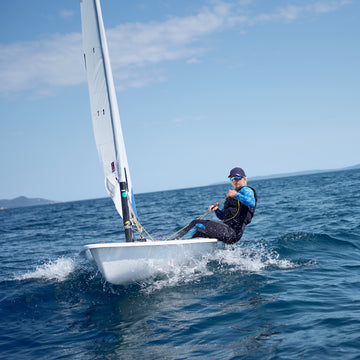
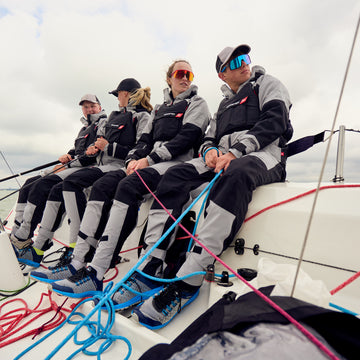
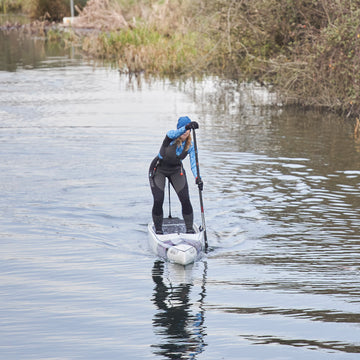
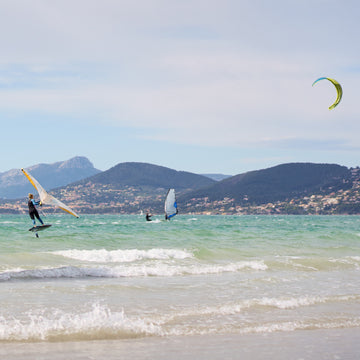

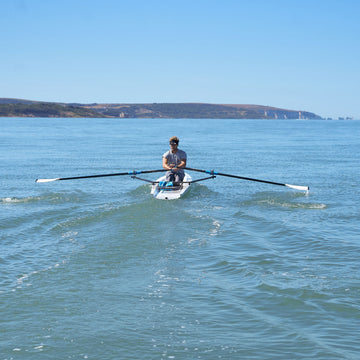
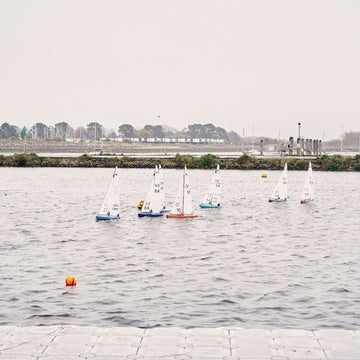
 Select Store
Select Store
 US
US
 UK
UK

